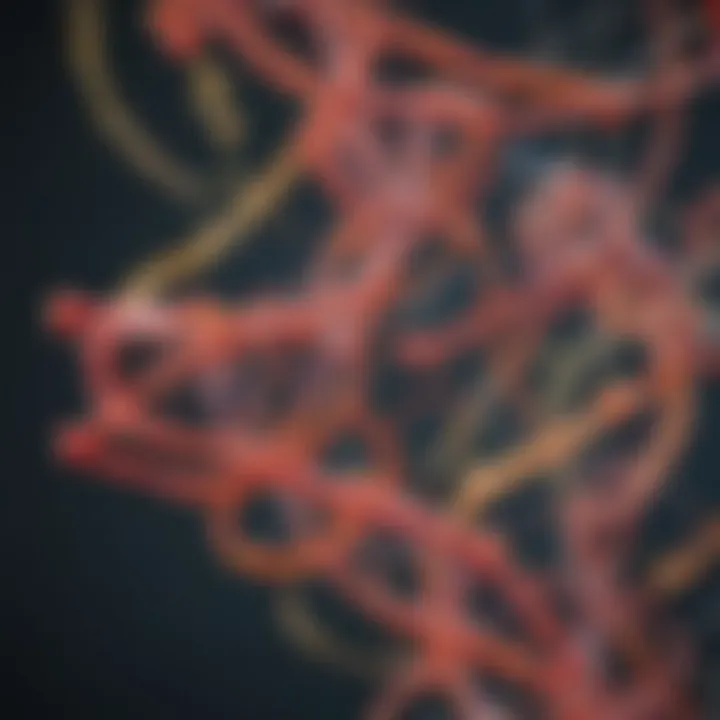Exploring Epigenetics in the Context of Aging


Intro
The study of aging has captivated scientists and educators for many years. With advances in technology and a deeper understanding of genetics, researchers increasingly turn their attention to epigenetics. This field involves the study of changes in gene expression without altering the underlying DNA sequence. The relationship between epigenetics and aging reveals how our environment and lifestyle can significantly influence biological processes over time.
Understanding this connection is paramount, particularly considering the rise in age-related diseases. As the global population ages, the need for innovative interventions to maintain health and quality of life becomes more pressing. This article will delve into the intricate links between epigenetics and aging, showcasing contemporary findings and discussing potential therapeutic strategies.
Prolusion to Epigenetics and Aging
Epigenetics represents a crucial layer of biological understanding, particularly when exploring the intricate process of aging. By establishing a framework to analyze how environmental and genetic factors interact, epigenetics sheds light on mechanisms that govern cellular aging and organismal health. In this article, we delve into the interplay of epigenetic factors and aging, aimed at providing insights for students, researchers, educators, and professionals.
The significance of this topic lies not only in its scientific curiosity but also in its practical implications. Understanding epigenetic mechanisms can lead to potential interventions in age-related diseases, which afflict millions globally. Furthermore, it unveils the possibility of modifying gene expression without altering the underlying genetic code. This aspect can be transformative, allowing for new therapeutic approaches in healthcare.
In considering epigenetics and aging, several key elements emerge:
- Epigenetic Mechanisms: Tools such as DNA methylation and histone modifications play a pivotal role in regulating gene expression.
- Environmental Influence: External factors, from diet to pollution, significantly impact epigenetic changes and thus affect aging.
- Therapeutic Potential: The exploration of epigenetic therapies presents opportunities to combat age-related diseases and improve longevity.
Studying these interconnections is not just an academic interest; it has profound implications for public health and personal well-being. As we progress, we will define epigenetics and age more thoroughly, establishing a base for this critical dialogue.
Defining Epigenetics
Epigenetics refers to changes in gene expression that occur without alterations to the underlying DNA sequence. This field explores how various factors can modify gene activity, steering cells toward different functions while maintaining their genetic integrity. Key mechanisms of epigenetics include DNA methylation and histone modification, which collectively orchestrate how genes are turned on or off strictly in response to varying stimuli.
Researchers suggest that epigenetic modifications are not static but dynamic processes affected by lifestyle choices and environmental exposure. Such flexibility allows organisms to adapt and survive in their environment. Epigenetics, therefore, is not just relevant for developmental biology but also for understanding diseases and aging.
Understanding Aging
Aging is a universal process characterized by the gradual decline in biological functions, resulting in the increased susceptibility to diseases and ultimately death. It encompasses a series of complex biological processes, influenced by genetic factors, epigenetics, and environmental conditions. While the biological mechanisms underpinning aging are multifaceted, current research emphasizes the role of cellular senescence, telomere shortening, and accumulation of epigenetic changes.
The impact of aging on human health has become a critical area of study as populations grow older. Age-related diseases, encompassing conditions such as cancer and neurodegenerative disorders, underline the urgency for understanding both the biological and epigenetic aspects of aging. As we deepen our understanding of how epigenetics intersects with aging processes, we may pave the way for effective interventions and improved quality of life for older adults.
Mechanisms of Epigenetic Regulation
The mechanisms of epigenetic regulation are central to understanding how epigenetics intersect with aging. They provide a framework for exploring how gene expression can be altered without changing the underlying DNA sequence. This is crucial as it highlights the dynamic nature of the genome and suggests that our environment, lifestyle, and experiences can influence genetic activity across an individual’s lifespan. Such knowledge offers potential pathways for interventions in age-related diseases, making it a significant focus in current research.
DNA Methylation
Mechanism of DNA Methylation
DNA methylation is a chemical modification where a methyl group is added to the DNA molecule, typically at cytosine bases. This process plays a pivotal role in regulating gene expression. A critical characteristic of DNA methylation is its ability to silence genes when methyl groups attach to specific sites, inhibiting their transcription. This makes it a beneficial choice for understanding how aging can lead to changes in gene expression patterns associated with age-related diseases. The unique feature of DNA methylation is its reversibility; it can be added or removed, which provides an avenue for potential therapeutic interventions to restore proper gene function.
Influence on Gene Expression
Influence on gene expression is one of the key outcomes of DNA methylation. Genes that are heavily methylated tend to be turned off, which means they do not produce proteins. This alteration affects various biological processes, including those related to aging. The characteristic of this influence is its specificity. Some genes are more susceptible to these epigenetic changes. Understanding this specificity can be beneficial because manipulating these expressions can help target age-related conditions more precisely. However, the disadvantage lies in the complexity of gene networks, as unintended gene silencing may lead to adverse effects on health.
Changes with Age


Changes in DNA methylation patterns as one ages are well-documented. These changes can lead to both global hypomethylation and region-specific hypermethylation. A key feature of these age-related changes is their potential to disrupt the balance of gene expression, contributing to age-associated disorders like cancer. This aspect is important because it suggests that tracking methylation changes could serve as a biomarker for biological aging. Nevertheless, the temporal nature of these changes poses a challenge, as it is essential to understand when these modifications occur and how they interact with external factors throughout life.
Histone Modification
Types of Histone Modifications
Histone modifications involve the chemical alteration of histone proteins around which DNA is wrapped. Common modifications include acetylation, methylation, phosphorylation, and ubiquitination. Each type plays a distinct role in gene regulation and chromatin architecture. The main feature of histone modifications is their ability to create a more open or closed chromatin structure, influencing how accessible the DNA is for transcription. This is a popular focus in epigenetic research since alterations in these modifications can lead to significant changes in gene expression linked to aging and disease development. One challenge is the complexity of interactions among different modifications, which can complicate the interpretation of their individual effects.
Role in Chromatin Structure
The role of histone modifications in chromatin structure is crucial for regulating gene access. These modifications can either loosen or tighten the associated DNA, thereby controlling the transcription of genes. A central characteristic of this role is the epigenetic memory that can be passed down during cell division. This makes histone modifications a significant focus in studies related to cellular aging and differentiation. However, the disadvantage is the variability in responses, as not all genes are equally affected, leading to unpredictable outcomes when trying to alter gene expression through histone manipulation.
Impact on Aging
The impact of histone modifications on aging is profound. Altered histone patterns have been observed in aging-related diseases and conditions. A notable characteristic here is the association of certain modifications with longevity in various model organisms. Understanding these links can provide insights into how epigenetic changes contribute to the aging process itself. However, it is vital to note that while some modifications may promote longevity, others can accelerate aging, indicating a duality that must be carefully navigated in research and potential treatments.
Non-Coding RNAs
Types of Non-Coding RNAs
Non-coding RNAs (ncRNAs) encompass a diverse group of RNA molecules that do not encode proteins. This includes microRNAs, long non-coding RNAs, and small interfering RNAs. The significance of ncRNAs comes from their regulatory roles in gene expression. A key feature here is that they can modulate gene activity at various levels, making them a beneficial focus for understanding age-related changes. The substantial challenge in studying these molecules is their vast diversity and functional overlap, which complicates the establishment of specific roles in aging.
Function in Gene Regulation
The function of non-coding RNAs in gene regulation is multifaceted. They can act by targeting messenger RNAs and preventing their translation or by modifying chromatin structure. A notable characteristic is their influence on developmental processes and cellular stress responses, both essential for healthy aging. Their promise lies in the potential for ncRNAs to serve as therapeutic targets for age-related diseases. Nevertheless, the difficulty remains in translating these findings into applicable treatments due to the complexity of cellular networks in which they operate.
Association with Aging
The association of non-coding RNAs with aging is an area of keen interest. Many studies suggest that changes in ncRNA expression patterns correlate with various age-related diseases. The key characteristic here is that some ncRNAs may serve as biomarkers for aging or therapeutic targets. This suggests a beneficial avenue for research since focusing on ncRNAs could yield insights into the aging process. A disadvantage, however, is that establishing causal relationships between specific ncRNAs and aging outcomes remains a challenge, needing more comprehensive studies to validate these findings.
Epigenetic Changes Across the Lifespan
Understanding epigenetic changes across the lifespan is crucial for comprehending how genetic expression evolves from conception to old age. Epigenetics, the study of heritable changes in gene expression that do not involve changes to the underlying DNA sequence, plays a significant role in development and age-related processes. The modifications that occur at various life stages influence cellular functions and can also predict susceptibility to diseases later in life. By analyzing how epigenetic factors vary across different life phases, one can better appreciate how aging is an interplay of stable genetic codes and dynamic environmental influences.
Developmental Epigenetic Landscape
The developmental phase represents a critical period where epigenetic changes set the foundation for future growth and health. These modifications include DNA methylation, which can silence or activate genes, and histone alterations that change how tightly DNA is wrapped. Early development is characterized by a high degree of plasticity, allowing for responsive changes based on environmental cues. For instance, maternal nutrition during pregnancy can lead to epigenetic modifications that influence the fetus's metabolic processes.
Moreover, the developmental epigenetic landscape varies across different tissues. Each tissue type may have a unique epigenetic profile that governs its specific functions. Understanding these patterns can help identify potential interventions for age-related diseases that arise from developmental epigenetic errors. Research in this area reveals that certain early-life experiences can lead to long-lasting effects on gene expression, suggesting a critical time window for interventions.
"Epigenetic modifications during developmental stages can have profound consequences on lifelong health and disease susceptibility."
Epigenetic Drift and Aging
As organisms age, epigenetic drift becomes evident. This term refers to random changes in DNA methylation and histone modification that accumulate over time. Unlike the precise changes occurring during development, drift represents a loss of regulation, leading to increased variability in gene expression. This drift can result in the activation of oncogenes or the silencing of tumor suppressors, thus contributing to the development of diseases such as cancer.
Epigenetic drift is often studied in the context of replicative senescence, where cells lose the ability to divide. It can also be influenced by external factors such as stress, diet, and environmental toxins, reinforcing the complex relationship between lifestyle and aging. The understanding of epigenetic drift opens avenues for research on potential therapeutic strategies to counteract its effects, ultimately aiming to provide a clearer path towards healthy aging.


In summary, both developmental epigenetic changes and epigenetic drift significantly impact the aging process. Addressing these factors can lead to innovations in preventive health strategies and therapeutic interventions aimed at improving longevity and healthspan.
Influence of Environmental Factors
The interplay between epigenetics and aging is significantly influenced by environmental factors. These elements can range from lifestyle choices to exposure to various chemicals. Understanding this relationship is essential, as it sheds light on how we can potentially modify our environment to promote healthier aging. This section focuses on two main categories: lifestyle factors and chemical exposures, both contributing to alterations in gene expression and overall health.
Lifestyle Factors
Diet and Nutrition
Diet and nutrition play a crucial role in shaping our epigenetic landscape. The foods we consume provide essential nutrients that can influence gene expression. For instance, diets rich in antioxidants, such as fruits and vegetables, can mitigate oxidative stress, which is a significant factor in aging.
A balanced diet is a beneficial choice as it not only curtails age-related disorders but also fosters resilience against environmental stressors. Unique features of a healthy diet include the consumption of omega-3 fatty acids found in fish, which may enhance cognitive function as we age. However, dietary choices can have disadvantages as well, such as excess sugar intake, which can lead to detrimental epigenetic modifications, underpinning metabolic disorders.
Physical Activity
Physical activity has profound effects on aging, promoting both physical and mental health. Regular exercise enhances blood circulation, reduces inflammation, and improves overall cellular function. Key characteristics of physical activity include its ability to stabilize body weight and strengthen muscle mass, which tend to decline with age.
In addition, exercise stimulates beneficial epigenetic changes, such as increased DNA methylation at specific gene loci. This can foster longevity and delay the onset of age-related diseases. On the downside, extreme or inadequate exercise may have adverse effects, including increased risk of injury or frailty in older adults.
Stress and Sleep
Stress and sleep patterns are important factors in the epigenetic landscape as well. Chronic stress can lead to various health complications, including elevated cortisol levels, which has been linked to adverse epigenetic changes. Key characteristics of managing stress involve employing coping mechanisms like mindfulness and relaxation techniques. Adequate sleep, at the same time, is essential in preserving cognitive function and emotional health.
Sleep acts as a reset for our systems and plays a role in the epigenetic regulation of circadian genes. The challenges arise when irregular sleep patterns disrupt this process, leading to potential exacerbation of age-related issues.
Exposure to Chemicals
Pesticides
Pesticides represent a crucial area of concern when analyzing environmental impacts on aging. Their alteration of gene expression has raised alarms regarding public health. Certain pesticides may induce epigenetic changes that increase susceptibility to diseases like cancer. The detrimental characteristics of these chemicals raise questions about their long-term use.
Despite any advantages they might offer to agricultural productivity, their persistent biological effects can lead to significant health risks, especially as they accumulate in the body over time.
Pollutants
Pollutants, including airborne and waterborne contaminants, contribute negatively to various health outcomes. They can cause oxidative stress and inflammation, leading to epigenetic changes associated with accelerated aging. The key aspect of pollutants is their ubiquitous presence in modern society, making them a challenging factor to avoid.
Unique features of pollutants include a range of effects that can impact not just individual health but also community wellness. Their presence in the environment can manifest in numerous health problems, highlighting the need for stricter regulations and cleaner alternatives to safeguard aging populations.
Endocrine Disruptors
Endocrine disruptors are chemicals that impede hormone functions and potentially lead to age-related diseases. They can include a range of substances, from plastics to personal care products. Key characteristics of endocrine disruptors lie in their profound ability to mimic hormones, thus affecting normal physiological processes.
The unique aspect of these disruptors is their lasting impact, leading to changes in reproductive health and metabolism, which can alter the aging process. Efforts are needed to raise awareness of these substances to mitigate their effects on longevity.
Epigenetics and Age-Related Diseases
Understanding the connection between epigenetics and age-related diseases is essential for both scientific inquiry and therapeutic strategies. The interplay of genetic factors and environmental influences shapes our health as we age. It becomes clear that age-related diseases such as cancer, neurodegenerative disorders, and cardiovascular diseases do not solely depend on genetics. Instead, epigenetic modifications have emerged as key players in how our genes express over time. These modifications can provide insights into the mechanisms behind diseases, guiding prevention and treatment.
Cancer
Cancer is one of the most significant age-related diseases influenced by epigenetic changes. Research has shown that alterations in DNA methylation patterns can lead to the activation of oncogenes or the silencing of tumor suppressor genes. For example, the hypermethylation of the promoter region of specific genes can prevent their expression, allowing cancerous cells to proliferate without regulation. This phenomenon highlights the need for understanding epigenetic alterations to develop targeted therapies. Epigenetic drugs, such as 5-azacytidine, aim to reverse aberrant methylation patterns, offering hope for treatments tailored to the individual’s epigenetic profile.
Neurodegenerative Disorders
Neurodegenerative disorders, including Alzheimer's disease and Parkinson's disease, also showcase the impact of epigenetics as we age. These diseases are characterized by the progressive degeneration of neurons, which can be influenced by both genetic predispositions and environmental factors. Studies reveal that epigenetic modifications, like histone acetylation and DNA methylation, can affect the expression of genes involved in neuronal health and inflammation. Understanding these associations might provide new avenues for early diagnosis and therapeutic interventions. For instance, compounds that modify histone acetylation could potentially enhance cognitive function or slow down neurodegeneration.
Cardiovascular Diseases


Cardiovascular diseases, a leading cause of mortality globally, are significantly affected by epigenetic changes. Factors such as diet, physical activity, and stress have been shown to lead to epigenetic modifications that influence vascular health. DNA methylation can alter the expression of genes related to lipid metabolism and blood pressure regulation. For example, the gene encoding angiotensinogen, which is crucial in blood pressure control, can be modified epigenetically. Therapies targeting these epigenetic modifications might reduce the incidence of cardiovascular diseases in aging populations, emphasizing the importance of lifestyle changes and epigenetic awareness in public health strategies.
"The exploration of epigenetics in age-related diseases allows us to rethink our approach to treatment and prevention, opening new doors for personalized medicine."
Therapeutic Potential of Epigenetic Interventions
The advancing field of epigenetics presents significant opportunities in developing therapeutic strategies tailored to counteract the aging process and its associated diseases. This section underscores the potential benefits of employing epigenetic interventions as a feasible approach in medical science. Given that epigenetic modifications can be reversible, targeting these changes holds promise for addressing age-related pathologies, improving healthspan, and possibly extending lifespan.
Epigenetic therapies can modify gene expression without altering the underlying DNA sequence. This flexibility may enhance the efficacy of traditional treatments for age-related diseases such as cancer, neurodegeneration, and cardiovascular issues. Furthermore, such interventions can be personalized, taking into account individual epigenetic profiles.
Notably, the development of drugs like decitabine and azacitidine, which aim to reverse abnormal DNA methylation patterns, illustrates significant progress in this domain. The capacity to restore normal gene expression through epigenetic modification represents a groundbreaking shift in therapeutic approaches, as current methods often do not target the root causes of these diseases.
Current Epigenetic Therapies
Current therapies focus primarily on re-establishing normal epigenetic marks that are typically altered with aging. For instance:
- DNA Methyltransferase Inhibitors: These include compounds like decitabine and azacitidine, which have shown promise in treating certain types of cancer by demethylating genes that suppress tumor growth.
- Histone Deacetylase Inhibitors: Agents such as vorinostat and romidepsin are used to modify histone acetylation, which can reactivate silent genes, including tumor suppressors.
- Gene Editing Technologies: Techniques like CRISPR/Cas9 may be adapted to target epigenetic elements directly.
Researchers are also exploring miRNA-based therapies that regulate gene expression post-transcriptionally. These therapies leverage the role of non-coding RNAs in influencing cellular functions and potentially restore balance in age-related epigenetic changes.
The adoption of these therapies, however, must consider potential side effects and long-term outcomes. The complexity of our epigenome means small changes can have unintended consequences.
Future Directions
Looking ahead, the field of epigenetic therapeutics is poised for further discovery and innovation. As researchers continue to delineate the epigenetic landscape associated with aging, several areas warrant attention:
- Combination Therapies: Integrating epigenetic interventions with traditional therapies may enhance efficacy and mitigate resistance mechanisms observed in various diseases.
- Personalized Epigenetic Medicine: Tailoring therapies to individual genetic and epigenetic profiles could optimize treatment outcomes and minimize risks.
- Understanding Epigenetic Reversion: Investigating how to safely reverse detrimental epigenetic changes related to lifestyle and environmental exposures remains a critical area of study.
The future of aging-related interventions lies in our ability to dynamically modify gene expression patterns to promote longer, healthier lives.
Finale
Understanding the intersection of epigenetics and aging is crucial in the modern study of biological science. As we delve into the complex mechanisms governing how our genes express themselves throughout life, it becomes clear that epigenetics plays a significant role in aging. This article has highlighted several key components of this relationship, such as the mechanisms of DNA methylation, histone modification, and the role of non-coding RNAs. These aspects help explain how gene expression can alter with age and how environmental factors can influence these changes.
The benefits of exploring this field are manifold. Recognizing the mechanisms whereby lifestyle choices impact aging presents opportunities for improving health outcomes. For instance, it suggests that interventions targeting epigenetic changes could potentially mitigate age-related diseases. Understanding the various influences—both genetic and environmental—provides a roadmap for future research, aiming to enhance the quality of life as we age.
"The significance of epigenetics in aging is paramount, suggesting pathways for interventions that could extend healthy lifespan."
Summary of Key Insights
This article has traversed the multifaceted domain of epigenetics and its connection to aging. Key insights include:
- Epigenetic Mechanisms: The core mechanisms, such as DNA methylation and histone modification, influence gene expression significantly throughout an individual's life.
- Impact of Environment: Environmental elements, including lifestyle choices and chemical exposures, can induce epigenetic changes that subsequently affect aging and contribute to various diseases.
- Age-Related Diseases: Certain age-related conditions, such as cancer and neurodegenerative disorders, are closely linked with aberrant epigenetic modifications.
- Potential for Therapies: There is immense potential for developing new therapeutic strategies that leverage our understanding of epigenetics to combat age-related diseases.
These insights illuminate the path forward in research and practical applications, emphasizing how our understanding of epigenetics continues to evolve with implications for health and wellness.
Final Thoughts on Epigenetics and Aging
The conversation around epigenetics and aging is rapidly developing. As research advances, our understanding of how epigenetic changes affect aging will deepen. Valuable findings suggest that not all aging is predetermined by genetics; rather, significant influence comes from lifestyle and environmental factors. This opens doors for proactive measures individuals can take to maintain their health.
In summary, epigenetics offers a promising frontier for interventions that may prevent or slow down aspects of aging. There is hope that ongoing investigations will reveal new therapeutic avenues, enabling us to adopt strategies that can enhance both longevity and life quality.
The connections between epigenetics and aging are complex but essential for comprehending the nature of our biological destiny. As this field continues to mature, it will undoubtedly provide substantial contributions to how we think about aging and health in the years to come.







